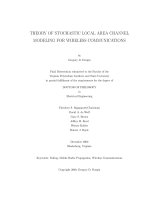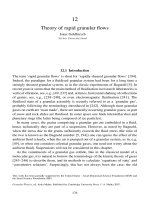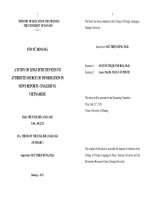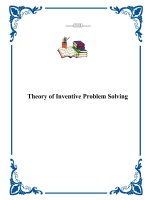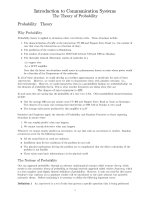Theory of semiconductor devices karl hess
Bạn đang xem bản rút gọn của tài liệu. Xem và tải ngay bản đầy đủ của tài liệu tại đây (5.82 MB, 338 trang )
ADVANCED THEORY OF
SEMICONDUCTOR DEVICES
IEEE Press
445 Hoes Lane, P.O. Box 1331
Piscataway, NJ 08855-1331
IEEE Press Editorial Board
Robert J. Herrick, Editor in Chief
J. B. Anderson
P. M. Anderson
M. Eden
M. E. El-Hawary
S. Furui
A. H. Haddad
S. Kartalopoulos
D. Kirk
P. Laplante
M. L. Padgett
W. D. Reeve
G. Zobrist
Kenneth Moore, Director ofIEEEPress
John Griffin, Acquisition Editor
Marilyn G. Catis, Assistant Editor
Surendra Bhimani, Production Editor
IEEE Electron Devices Society, Sponsor
ED-S Liaison to IEEE Press, Kwok Ng
IEEE Solid-State Circuits Society, Sponsor
SSC-S Liaison to IEEE Press, Stuart K. Tewksbury
Composition: William Henstrom
Illustration: Robert F. Mac Farland
Cover design: Sharon Klein, Sharon Klein Graphic Design
Books of Related Interest from IEEE Press
NONVOLATILE SEMICONDUCTOR MEMORY TECHNOLOGY:
A Comprehensive Guide to Understanding and Using NVSM Devices
Edited by William Brown and Joe E. Brewer
1998 Hardcover 616 pp
ISBN 0-7803-1173-6
SEMICONDUCTOR MEMORIES: Technology, Testing, and Reliability
Ashok K. Sharma
1997 Hardcover
480 pp
HIGH-TEMPERATURE ELECTRONICS
Edited by Randall Kirschman
1998 Hardcover 912 pp
ISBN 0-7803-1000-4
ISBN 0-7803-3477-9
ADVANCED THEORY OF
SEMICONDUCTOR DEVICES
Karl Hess
University of Illinois at Urbana-Champaign
IEEEElectron Devices Society, Sponsor
IEEESolid-State Circuits Society, Sponsor
+IEEE
The Instituteof Electrical and Electronics Engineers, Inc., NewYork
roWILEY-
~INTERSCIENCE
A JOHNWILEY & SONS, INC., PUBLICATION
NewYork • Chichester •Weinheim • Brisbane • Singapore •Toronto
e 2000 THE INSTITUTE OF ELECTRICAL
AND ELECTRONICS
th
ENGINEERS, INC. 3 Park Avenue, 17 Floor, New York, NY 10016-5997
All rights reserved.
No partof this publication maybe reproduced, storedin a retrieval system, or
transmitted in any formor by any means,electronic, mechanical,
photocopying, recording, scanning or otherwise, exceptas permitted under
Sections 107and 108of the 1976UnitedStatesCopyright Act, withouteither
the prior writtenpermission of the Publisher, or authorization through
payment of the appropriate per-copy fee to the Copyright Clearance Center,
222 Rosewood Drive,Danvers, MA01923,(978) 750-8400, fax (978)7504744.Requests to the Publisher for permission shouldbe addressed to the
Permissions Department, John Wiley & Sons,Inc., 605 ThirdAvenue, New
York,NY 10158-0012. (212) 850-6011, fax (212)850-6008, E-mail:
For ordering and customer service, call1-800-CALL-WILEY.
Wiley-IEEE Press ISBN 0-7803-3479-5
10 9 8 7 6 5 4 3 2
Library of Congress Cataloging-in-Publication Data
Hess, Karl, 1945Advanced theory of semiconductor devices I Karl Hess.
p. cm.
Includes bibliographical references (p. ).
"IEEE Electron Devices Society, sponsor."
"IEEE Solid-State Circuits Society, sponsor."
ISBN 0-7803-3479-5
I. Semiconductors. I. Title.
TK7871.85.H475 1999
621.3815'2--dc21
99-44500
CIP
To the memory of my father
Karl Joseph Hess
CONTENTS
Preface
xiii
Acknowledgments
xv
Chapter 1
A Brief Review of the Basic Equations
1.1 The Equations of Classical Mechanics, Application
to Lattice Vibrations
2
1.2 The Equations of Quantum Mechanics
9
Chapter 2
The Symmetry of the Crystal Lattice
2.1
Crystal Structures of Silicon and GaAs
2.2
Elements of Group Theory
22
2.3
2.2.1
2.2.2
Point Group
22
TranslationalInvariance
Bragg Reflection
29
1
19
19
26
Chapter 3
The Theory of Energy Bands in Crystals
3.1
Coupling Atoms
33
3.2
Energy Bands by Fourier Analysis
34
3.3
Equations of Motion in a Crystal
42
3.4
Maxima of Energy Bands-Holes
46
3.5
Summary of Important Band-Structure
Parameters
50
3.6
Band Structure of Alloys
50
33
Chapter 4
Imperfections of Ideal Crystal Structure
4.1
Shallow Impurity Levels-Dopants
58
4.2
Deep Impurity Levels
60
4.3
Dislocations, Surfaces, and Interfaces
62
57
vii
viii
Contents
Chapter 5
Equilibrium Statistics for Electrons and Holes
5.1
Density of States
67
5.2
Probability of Finding Electrons in a State
73
5.3
Electron Density in the Conduction Band
75
Chapter 6
Self-Consistent Potentials and Dielectric Properties 81
6.1
Screening and the Poisson Equation in One
Dimension
82
6.2
Self-Consistent Potentials and the Dielectric
Function
83
Chapter 7
Scattering Theory
7.1
General Considerations-Drude Theory
7.2
Scattering Probability from the Golden
Rule
94
7.3
7.2.1
7.2.2
7.2.3
Impurity Scattering
94
Phonon Scattering
96
Scattering by a S-ShapedPotential
89
67
89
102
Important Scattering Mechanisms in Silicon and
Gallium Arsenide
103
Chapter 8
The Boltzmann Transport Equation
109
8.1
Derivation
109
8.2
Solutions of the Boltzmann Equation in the
Relaxation Time Approximation
114
8.3
Distribution Function and Current Density
121
8.4
Effect of Temperature Gradients and Gradients of
the Band Gap Energy
125
8.5
Ballistic and Quantum Transport
127
8.6
The Monte Carlo Method
129
Chapter 9
Generation-Recombination
9.1
Important Matrix Elements
9.1.1
9.1.2
9.2
9.3
9.4
135
135
RadiativeRecombination
135
Auger Recombination
139
Quasi-Fermi Levels (Imrefs)
139
Generation-Recombination Rates
140
Rate Equations
144
Chapter 10 The HeteroJunction Barrier
10.1 Thermionic Emission of Electrons over
Barriers
147
147
Contents
ix
10.2 Free Carrier Depletion of Semiconductor
Layers
151
10.3 Connection Rules for the Potential at an
Interface
153
10.4 Solution of Poisson's Equation in the Presence of
Free Charge Carriers
154
10.4.1
10.4.2
Classical Case
154
Quantum Mechanical Case
157
10.5 Pronounced Effects of Size Quantization and
Heterolayer Boundaries
162
Chapter 11 The Device Equations of Shockleyand Stratton
11.1 The Method of Moments
167
11.2 Moment for the Average Energy and Hot
Electrons
170
11.2.1
11.2.2
11.2.3
Steady-StateConsiderations
171
VelocityTransients and Overshoot
175
Equation of Poisson and Carrier Velocity
176
Chapter 12 Numerical Device Simulations
12.1 General Considerations
181
12.2 Numerical Solution of the Shockley
Equations
184
12.2.1
13.2.5
13.2.6
13.2.7
13.2.8
13.2.9
13.3
194
Introduction and Basic Physics
201
Basic Equations for the Diode Current
207
Steady-State Current in Forward Bias
211
AC Carrier Concentrations and Current in Forward
Bias
213
Short Diodes
215
Recombinationin Depletion Region
216
Extreme Forward Bias
219
Asymmetric Junctions
221
Effects in Reverse Bias
223
High-Field Effects in Semiconductor
Junctions
226
13.3.1
181
Numerical Simulation Beyond the Shockley
Equations
188
Chapter 13 Diodes
13.1 Schottky Barriers-ohmic Contacts
201
13.2 The p-n Junction
13.2.1
13.2.2
13.2.3
13.2.4
167
Role of Built-In Fields in Electron Heating and p-n
Junction Currents
226
193
x
Contents
13.3.2
13.3.3
13.3.4
13.4
Impact Ionization in p-n Junctions
Zener Tunneling
236
Real Space Transfer
240
229
Negative Differential Resistance and
Semiconductor Diodes
241
Chapter 14 Laser Diodes
14.1 Basic Geometry and Equations for Quantum Well
Laser Diodes
248
14.2 Equations for Electronic Transport
250
14.3 Coupling of Carriers and Photons
253
14.4 Numerical Solutions of the Equations for Laser
Diodes
257
247
Chapter 15 Transistors
15.1 Simple Models
265
15.1.1
15.1.2
15.2
Effects of Reduction in Size, Short Channels
278
15.2.1
15.2.2
15.3
266
Bipolar Transistors
266
Field Effect Transistors
272
Scaling Down Devices
278
Short Gates and Threshold Voltage
HotElectron Effects
15.3.1
15.3.2
279
281
Mobility in Small MOSFETs
281
Impact Ionization, Hot Electron Degradation
284
Chapter 16 Future Semiconductor Devices
16.1 New Types of Devices
291
16.1.1
16.1.2
16.2
Extensions of Conventional Devices
291
Future Devices for Ultrahigh Integration
293
Challenges in Nanostructure Simulation
16.2.1
16.2.2
16.2.3
291
295
Nanostructures in Existing Semiconductor
Devices
296
Quantum Dots
297
Structural, Atomistic, and Many-Body
Effects
297
Appendix A Tunneling and the Golden Rule
301
Appendix B The One Band Approximation
305
Contents
xi
Appendix C Temperature Dependence of the Band Structure
307
Appendix 0 Hall Effect and Magnetoresistance
309
Appendix E The Power Balance Equation
311
Appendix F The Self-Consistent Potential at a Heterojunction
315
Appendix G Schottky Barrier Transport
317
Index
321
About the Author
333
PREFACE
This book evolved from my earlier book of the same title. Chapters have been
added (e.g., one on laser diodes); others have been completely rewritten (e.g.,
the chapter on the Boltzmann equation).
Semiconductor devices are now the substrates of information and computation-the substrates of Internet browsers that sift with great speed through a
world of information and represent the information visually to the user, and the
substrates of artificial intelligence. They form the basis of all computer chips, of
solar cell arrays, and of the newer red lights on cars. They are essential in fiber
communications, and laser diodes are among the most sophisticated semiconductor devices. They are truly ubiquitous and can be found in increasing numbers
in cars, kitchens and even in electronic door locks. Trillions of the basic semiconductor devices, p-n junction diodes, are fabricated daily, and Moore's law of
increasing the integration and reducing the device size every 18 months has been
persistently obeyed.
My goal is to present a description of the theoretical concepts underlying
device function and to cover device theory from the principles of condensed
matter physics and chemistry to the numerical mathematics of device simulation
tools, all in a form understandable for anyone who knows advanced calculus and
some numerical algorithms important for the solution of the device equations,
the Boltzmann equation, and the Schroedinger equation. This goal could not be
achieved. Instead I have presented only an overview of some of the most important concepts of selected devices. To obtain a truly broad knowledge of device
theory, the reader will need to study additional books that are referenced, particularly the SolidState Theory edited by Landsberg, the encyclopedic description of
most devices by Sze, and the text on numerical device simulation by Selberherr.
Karl Hess
University ofIllinois at Urbana-Champaign
xiii
ACKNOWLEDGMENTS
I would like to express my sincere thanks to Wolfgang Fichtner, who has stimulated the revision and invested much time to give advice for improvement.
B. G. Streetman, R. Dutton, and M. Lundstrom have given valuable adviceduring many important stages of the development of this book. Others have contributed to various sections: P. D. Yoder to the section on the densityof statesand
Monte Carlo simulations, J. Bude to the sections on impact ionization through
his insight, S. Laux to the chapteron diodes as the major contributor to the new
treatment of p-n junctions, Alex Trellakis to the explicit solution for the even
part of the distribution function, M. Grupen to the insights presented in the chapter on laserdiodes basedon his pathbreaking workon laserdiode simulation, and
L. F. Register to the theory of collision broadening in Monte Carlo simulations
and to someof the treatment of the electron phonon interactions.
I thank J. P. Leburton, U. Ravaioli, M. Staedele, F.Oyafuso, B. Klein, F.Register, E. Rosenbaum, and B. Tuttlefor reading selected chapters and suggesting
improvements, and the students in my classes who have found and corrected
many mistakes.
Special thanks go to L. R. Cooper from the Office of Naval Research, to
M. Stroscio from the Army Research Office, and to George Lea from the National Science Foundation for their insights regarding the importance of topical
areas and for their encouragement. G. J. Iafrate has worked with me on many
topics and has influenced my thinking from velocity overshoot to quantum capacitance.
The Beckman Institute of the University of Illinois and its first directors,
T.L. Brown and J. Jonas,haveprovided an idealenvironment to covertheoretical
expertise of a range of disciplines including basic physics, chemistry, electrical
engineering, and numerical mathematics.
William Henstrom has performed above and beyond duty in creating layout
and composite workand correcting my feeble attempts in IMEX.
Very special thanks go to my wife Sylvia, my daughter Ursula S., and my
son Karl H. for theirlovingsupport.
Karl Hess
University ofIllinois at Urbana-Champaign
xv
CHAPTER
1
A BRIEF REVIEW OF THE
RELEVANT BASIC
EQUATIONS OF PHYSICS
From a mathematical viewpoint, all equations of physics (both microscopic and
macroscopic) are relevant for semiconductor devices. In an absolutely strict
mathematical way, we therefore would have to proceed from the fundamentals
of quantum field theory and write down the ~ 1023 coupled equations for all the
atoms in the semiconductor device. Then we would have to solve these equations, including the complicated geometrical boundary conditions. However, the
outcome of such an attempt is clear to everyone who has tried to solve only one
of the 1023 equations.
Any realistic approach oriented toward engineering applications has to proceed differently. Based on the experience and investigations of many excellent
scientists in this field, we neglect effects that would only slightly influence the results. In this way many relativistic effects become irrelevant. In my experience,
the spin of electrons plays a minor role in the theory of most current semiconductor devices and can be accounted for in a simple way (the correct inclusion
of a factor of 2 in some equations).
Most effects of statistics can be understood classically, and we will need
only a very limited amount of quantum statistical mechanics. This leaves us essentially with the Hamiltonian equations (classical mechanics), the Schrodinger
equation (quantum effects), the Boltzmann equation (statistics), and the Maxwell
equations (electromagnetics).
It is clear that the atoms that constitute a solid are coupled, and therefore the
equations for the movement of atoms and electrons in a solid are coupled. This
still presents a major problem, a many-body problem. We will see, however,
that there are powerful methods to decouple the equations and therefore make
single particle solutions possible. The many interacting electrons in a solid are
then, for example, replaced by single independent electrons moving in a periodic
potential. Complex many body effects, such as superconductivity, are then excluded from our treatment, which is justified because of the low electron density
in typical semiconductors. We also exclude in our treatment effects of extremely
high magnetic fields because these are unimportant for most device applications.
1
Chap. 1
2
A Brief Review of the Basic Equations
In this way, the fundamental laws of physics are finally reduced to laws of semiconductor devices that are tractable and whose limitations are clearly stated. The
following sections are written with the intent to remind the reader of the basic
physics underlying device operation and to review some of the physicist's tool
kit in solid-state theory.
1.1 THE EQUATIONS OF CLASSICAL MECHANICS,
APPLICATION TO LATTICE VIBRATIONS
Hamilton was able to give the laws of mechanics a very elegant and powerful
form. He found that these laws can be closely linked to the sum of kinetic and
potential energy written as a function of momentumlike (Pi) and spacelike (Xi)
coordinates.
This function is now called the Hamiltonianfunction H(pi,Xi). The laws of
mechanics are
aH(Pi,Xi)
aXi
dPi _
dt -
(1.1)
and
dx,
aH(Pi,Xi)
dt =
dPi
(1.2)
where t is time and i = 1,2,3. Instead of Xi, we sometimes denote the space
coordinates by x,y,Z.
Some simple special cases can be solved immediately. The free particle
(potential energy =zero) moves according to
H= LPi2/2m
i
and we have from Eq. (1.1)
~i = 0;
Pi = constant,
which is Newton's first law of steady motion without forces.
If we have a potential energy V (Xl) that varies in the Xl direction, we obtain
from Eq. (1.1)
dp, _ aV(x.) - F.
dt --~= 0
(1.3)
The quantity defined as Fo is the force, and Eq. (1.3) is Newton's second law of
mechanics.
A more involved example of the power of Hamilton's equations is given
by the derivation of the equations for the vibrations of the atoms (or ions) of
the crystal lattice. As we will see, these vibrations are of utmost importance
Sec. 1.1
The Equations of Classical Mechanics, Application to Lattice Vibrations
o
o
o
o
o
o
3
Figure 1.1 Displacement u;(r) of atoms in a crystal lattice.
in describing electrical resistance. They also give a fine example of how the
many-body problem of atomic motion can be reduced to the solution of a single
differential equation by using the crystal symmetry (group theory from a mathematics point of view) by a cut-off procedure. Here we cut off the interatomic
forces beyond the nearest neighbor interaction. We also introduce below cyclic
boundary conditions, which are of great importance and convenience in solidstate problems.
It suffices for this section to define a crystal, and we will be mostly interested in crystalline solids, as a regular array of atoms hooked together by atomic
forces. "Regular" means that the distance between the atoms is the same throughout the structure. Many problems involving lattice vibrations can be solved by
classical means (i.e., using the Hamiltonian equations) because the atoms that
vibrate are very heavy. Then we only have to derive the kinetic and potential
energy. Because we would like to describe vibrations (i.e., the displacement of
the atoms), we express all quantities in terms of the atomic displacements u;(r),
where i = x,y,Z and r is the number (identification) of the atom. It is important
to note that r is not equal to the continuous space coordinate r in this chapter, although it has similar significance because it labels the atoms. The displacement
of an atom in a set of regularly arranged atoms is shown in Figure 1.1.
We follow the derivations in Landsberg [5] and express the kinetic energy T
by
at
IM~ 2( ) h
u·(r) __ au;(r)
T= 2
~ Ui r
were
n
(1.4)
and M is the mass of the atoms (ions).
We assume now that the total potential energy U of the atoms can be expressed in terms of a power series in the displacements,
U = Uo + LBiu;(r) + ~ LBiju;(r)uj(s) +...
n
rs
ij
(1.5)
4
Chap. 1
A Brief Review of the Basic Equations
where s also numbers the atoms as r does.
The following results rest on this series expansion and truncation, which
makes a first principle derivation (involving many body effects) unnecessary.
Equation (1.5) is, of course, a Taylor expansion with
-:»:
I
(1.6)
dUi(r)
Because the crystal is in equilibrium, that is, at a minimum of the potential energy
U, the first derivative vanishes and
(1.7)
Bi=O
We further have
Br:~ =
I}
iPu
dUi(r)duj(s)
=
1JS{'
}l
(1.8)
We now use the fact that the crystal is translationally invariant-that is, we
can shift the coordinate system by s atoms (start to count s atoms later), and the
crystal is transformed into itself (at least if it is infinite). Therefore,
(1.9)
Furthermore, a rigid displacement (all Ui equal) of the crystal does not change U
and we therefore have, from Eqs. (1.5) and (1.9),
LB?J = 0
r
(1.10)
To derive Eq. (1.9), we have assumed an infinite crystal. We also could have
introduced so-called periodic or cyclic boundary conditions; that is, continue the
crystal by repeating it over and over. In one dimension, this means we consider
only rings of atoms (Figure 1.2). This approach amounts to neglecting any surface effects or other effects that are sensitive to the finite extension of crystals.
We can now derive the equations of motion by using Eqs. (1.1) and (1.2)
with coordinates ui(r) instead of Xi:
.( )
dH(Pi,Ui)
Pi r =dU;
(1.11)
Pi(r) = MUi(r)
(1.12)
and
Eq. (1.11) gives
(1.13)
Sec. 1.1
The Equations of Classical Mechanics, Application to Lattice Vibrations
S
Figure 1.2 A ring of atoms representing cyclic boundary conditions.
Here, also, the indices m,n are used to number the atoms (as ',S above). Therefore
p;(r) = - LBijuj(s)
s.]
and, together with Eq. (1.12), one obtains
Mu;(r) + LBijuj(s)
s,j
=0
(1.14)
Remember that the index S in Eq. (1.14) runs over a large number of atoms;
that is, up to about 1023 in a typical crystal. The r can also assume any of these
numbers. In other words, we have about 1023 coupled equations to solve. This
situation is very typical for any type of solid-state problem, but by far not as
hopeless as it may seem. Powerful methods have been developed to reduce the
number of equations and the following treatment is representative. We will assume for simplicity that the crystal is one dimensional and avoid the complicated
geometrical arrangement of atoms in a real crystal. (We will learn more about
this when we discuss the electrons and their motion in crystals.)
In the three-dimensional case, Eqs. (1.7) through (1.10) are very helpful;
they reduce the numbers of parameters. Without going into details, we mention
that this reduction of parameters is generally accomplished by group theoretical
arguments, and Eq. (1.9) is a direct consequence of the translational invariance
(group of translations).
6
Chap. 1
A Brief Review of the Basic Equations
To proceed explicitly with our one-dimensional model, we need to make the
drastic assumption that each atom interacts only with its nearest neighbor. (We
can use the same method also for second, third ... nearest neighbor interaction, if
we proceed numerically and use a high-speed computer.) Our assumption means
B'" =1= 0
s = r± 1
only for
Notice that we dropped the indices i, j because this is a one-dimensional
problem. Without any loss of generality, we may assume r = O. Then we have
BOs =/=0
for
s = ±1
and
BOs = 0
otherwise
(1.15)
Furthermore,
according to Eq. (1.9) and
B- 10 == BO( -
1)
according to Eq. (1.8). Therefore,
B01 =BO( -
l)
From Eq. (1.10) we obtain
(1.16)
It is now customary to denote B01 = BO(-l) by -a (a is the constant of the
"spring" forces that hold the crystal together) and therefore dXl by 2a. The
equation of motion, Eq. (1.14), then becomes for any r
Mu(r) = -2au(r) +au(r-l) + au(r+ 1)
(1.17)
Eq. (1.17) leaves us still with 1023 coupled differential equations. However,
these equations are now in tridiagonal form, all with coefficient e, Such a form
can be reduced to one equation by skillful substitution. The substitution can
be derived from Bloch's theorem, which we will discuss later. It also can be
guessed:
u( r)
= ueiqra
( 1.18)
Note that the amplitude u is still a function of time. Here a is the distance between atoms (i.e., the lattice constant). Eq. (1.17) becomes
Mue iqra = -2aueiqra + aueiqrae-iqa
which gives
Mil = au(2cosqa - 2)
+ aueiqraeiqa
(1.19)
Sec. 1.1
The Equations of Classical Mechanics, Application to Lattice Vibrations
7
v
_1!
q
1!
a
a
Figure 1.3 Dispersion relation v(q) for lattice vibrations. (Remember, E
and
..
U=
= hv.)
(a q )
-4au. 2 --sIn
M
2
This gives
(1.20)
with
q
v =2lsin a2
l
~
(1.21)
This means that the atoms are oscillating in time with frequency v, which is a
function of the wave vector q. The function is shown in Figure 1.3.
There are several important points to notice. First,at q = -1t/ a and q = 1t/ a,
the energy has its highest value. For these q, the wavelength A. = 21t/q has the
value A= 2a. As can be seen from Figure 1.4, this is the shortest wavelength
that we really need to describe the physics of the lattice vibrations. Shorter
wavelengths lead only to "wiggles" between the atoms, but the displacements
are actually the same. For example, if q = 31t/a and A= 2/3a, the atoms are
displaced in exactly the same way as for q = tt]«. In other words, for any q
outside the zone -1t/a ~ q ~ 1t/a, which is called the Brillouin zone, we can
find a q inside the zone that describes the same displacement, energy, and so
f\
(
·\/.'V ·v
(\
/\
,\
v=~
I \
Figure 1.4 Illustration of the shortest possible physical wavelength of lattice vibrations.
8
Chap. 1
A Brief Review of the Basic Equations
on. Notice that in a real crystal the arrangement of atoms is different in different directions. Therefore, the three-dimensional Brillouin zone is usually a
complicated geometrical figure (see Chapter2).
Second, q is not a continuous variable because of the boundary conditions.
Consider, for example, the ring of Figure 1.2 with eight atoms and
u(O) = u(8)
or, in general, for N atoms, we have
and u(N) = u(O)eiqNa
u(N) = u(O)
Therefore eiqNa equalsone, and we conclude that q = 21tl/Na where 1 is an
integer. If werestrictq to the firstBrillouin zone,we have -N /2 ~ I ~ N /2. This
means that q assumes only discrete (not continuous) values. However, because
of the large numberN, it can almost be regarded as continuous.
Third, without emphasizing it, we have developed a microscopic ·theory of
soundpropagation in solids. For small wave vectors q (Le., large A), we have
. qa qa
Sln-
2
~-
2
and
v=
~qa
(1.22)
Using AV = vs , where V s is the velocity of sound, we obtain
Vs
=
2TCa~
(1.23)
whichis a microscopic description of the soundvelocity.
In real crystals additional complications arise from the fact that we can have
two or even more different kinds of atoms. These atoms may oscillate as the
identical atoms in the above example. There are, however, different modes of
oscillation possible. If we think of a chain with two different kinds of atoms, it
can happenthat onekindof atom(black) oscillates againstthe otherkind (white).
Such an oscillation can take place, and indeed does, at a very high (optical)
frequency, and the corresponding latticevibrations are called opticalphonons. It
is very important to note that in principle all black atoms can oscillate in phase
againstthe whiteones. This meansthat we can havehigh frequencies (energies)
even if the wavelength is very large or the q vector is very small (Figure 1.5).
o •
o •
o •
Figure 1.5 Two different kinds of atoms oscillating against each other. This represents a
wave with high energy (frequency) and small wave vector.
9
Sec. 1.2 The Equations of QuantumMechanics
v
Optic
a7t
q
Figure 1.6 Schematic v(q) diagramfor acousticand optic phononsin one dimension.
The energy versus q relation can then have two branches, the acoustic and the
optic, as shown in Figure 1.6.
The presence of two different atoms can also cause long-range coulombic
forces owing to the different charge on the two atom types (ionic component).
The long-range forces cannot be described by simple forces between neighboring atoms, and one calls the phonons polar optical phonons if these long-range
forces are important.
As mentioned, lattice vibrations are important in various ways. Electrons interact with the crystal lattice exciting (emitting) and absorbing lattice vibrations
(the net lost energy is known as Joules heat). The system of electrons by itself is
therefore not a Hamiltonian system; that is, one in which energy is conserved. It
is only the sum of electons and lattice vibrations which is Hamiltonian.
The interested reader is encouraged to obtain knowledge of a detailed quantum picture of lattice vibrations (also phonons) and their interactions with electrons as described, for example, by Landsberg [5].
1.2 THE EQUATIONS OF QUANTUM MECHANICS
At the beginning of the twentieth century, scientists realized that nature cannot be
strictly divided into waves and particles. They found that light has particle-like
properties and cannot always be viewed as a wave, and particles such as electrons
revealed definite wave-like behavior under certain circumstances. They are, for
example, diffracted by gratings as if they had a wavelength
A=
h
!Pi
(1.24)
10
Chap. 1
A Brief Review of the Basic Equations
where Ii == h/2rc ~ 6.58 x 10- 16 eVs is Planck's constant and p is the electron
momentum.
Schrodinger demonstrated that the mechanics of atoms can be understood
as boundary value problems. In his theory, electrons are representedby a wave
function 'I'(r), which can have real and imaginary parts, and follows an eigenvalue differential equation:
2
( - ::V
+ v(r)) 'Jf(r) = E'Jf(r)
(1.25)
The part of the left side of Eq. (1.25) that operates on 'l'is now called the Hamiltonian operator H. Formally this operator is obtained from the classical Hamiltonian by replacing momentum with the operator Vn/i (i = imaginary unit),
where
v= (~,~,~)
The meaning of the wave function '1'( r) was not clearly understood at the
time Schrodingerderived his famous equation. It is now agreed that 1'I'(r)1 2 is
the probabilityof finding an electronin a volumeelementdr at r. In other words,
we have to think of the electron as a point charge with a statisticalinterpretation
of its whereabouts (the wave-like nature). It is usually difficult to get a deeper
understanding of this viewpoint of nature;evenEinsteinhad trouble with it. It is,
however, a very successful viewpoint that describes exactly all phenomena we
are interestedin. To obtain a better feeling for the significance of W(r), we will
solve Eq. (1.25) for several special cases. As in the classical case, the simplest
solutionis obtainedfor constantpotential. Choosingan appropriate energyscale,
we put V (r) = 0 everywhere.
By inspectionwe can see that the function
Cexp(ik·r) ~ C(cosk·r+isink·r)
(1.26)
is a solution ofEq. (1.25) with
(1.27)
and C a constant.
The significance of the vector k can be understood from analogies to wellknown wave phenomenain optics and from the classical equations. Because E
is the kinetic energy, 1ik has to be equal to the classical momentum p to satisfy
E = p2 / 2m. On the other hand, in optics
[k] = 2rt/'"A
which gives, together with Eq. (1.24),
nk=p
which is consistent with the mechanical result.
(1.28)
Sec. 1.2
The Equations of Quantum Mechanics
11
How can the result of Eq. (1.26) be understood in terms of the statistical
interpretation of '1'( r)? Apparently
1'I'(r)1 2 =
leI 2 (cos2 k . r + sin2 k . r ) = ICl 2
This means that the probabilityof findingthe electron at any place is equal to e2 •
If we know that the electron has to be in a certain volume Vol (e.g., of a crystal),
then the probability of finding the electron in the crystal must be one. Therefore,
{ ICl 2 dr = VoIICl 2 = 1
iVoI
and
lei = 1/v%
(1.29)
In other words, the probability of finding an electron with momentum lik at a
certain point r is the same in the whole volume and equals l/Vol. We will give
a more detailed discussion of this somewhat peculiar result in the next section.
The unfamiliar reader is referred to an introductory text (e.g., Feynman [3]).
Note that by confining the electron to a volume, we have already contradicted our assumption of constant potential V(r) = O. (Electrons can only be
confined in potential wells.) If, however, the volume is large, our mistake is
insignificant for many purposes.
Let us now consider the confinement of an electron in a one-dimensional
potential well (although such a thing does not exist in nature). We assume that
the potentialenergy V(r) is zero over the distance (O,L) on the x-axis and infinite
at the boundaries 0 and L.
The Schrodinger equation, Eq. (1.25), reads in one dimension (x-direction,
V(x) = 0)
a
ax
2
_ r,,2 ",(x) = E (x)
2
2m
'I'
(1.30)
",(X)=[iSin";x with n=I,2,3,...
(1.31)
Inspection shows that the function
satisfies Eq. (1.30) as well as the boundary conditions. The boundary conditions
are, of course, that 'I' vanishes outside the walls, since we assumed an infinite
impenetrable potential barrier. In the case of a finite potential well, the wave
function penetrates into the boundary and the solution is more complicated. If
the barrier has a finite width, the electron can even leak out of the well (tunnel).
This is a very important quantum phenomenon the reader should be familiar
with. We will return to the tunneling effect below.
The wave function, Eq. (1.31), corresponds to energies E (called eigen energies)
(1.32)
12
Chap. 1
A Brief Review of the Basic Equations
Because n is an integer, the electron can assume only certain discrete energies
while other energies are not allowed. These discrete energies that can be assumed
are called quantum states and are characterized by the quantum number n. The
wave function and corresponding energy are therefore also denoted by 'l'n, En.
Think ofa violin string vibrating in various modes at higher and lower tones
(frequency v), depending on the length L, and consider Einstein's law:
E = hv
(1.33)
If we compare the modes of vibration of the string with the form of the wave
function for various n, then we can appreciate the title of Schrodinger's paper,
"Quantization as a Boundary Value Problem."
Devices that contain a well and feature quantized energy levels similar to the
ones given in Eq. (1.32) do exist. Quantum well lasers typically contain one or
more small wells and the well size controls the electron energy. However, in most
devices, the wells are not rectangular. In silicon metal oxide semiconductor field
effect transistors (MOSFETs), the well is closer to triangular and its shape depends on the electron density (Le., the charge in the well). We will deal with this
charge-dependent well shape in Chapter 10. Here we discuss only well-defined
potential problems-c-eases where the potential is given and fixed. With current
high-end workstations, the Schrodinger equation can then be solved numerically
for an arbitrary (but given) potential shape. One-dimensional problems can be
solved by standard discretization (transforming the differentiations into finite differences) and by solving the resulting matrix equations by standard solvers such
as found in EISPACK and LAPACK. For two- and three-dimensional problems,
this procedure still leads to a prohibitively large number of equations (which
grows with the third power of the number of discretization points). Therefore
the discretized mesh must be coarsened even when using the fastest supercomputers. Often, however, one is interested only in relatively small sets of eigen
values, for example, the first three [as for n = 1,2,3 in Eq. (1.31)].
One then can use so-called subspace interaction techniques that only resolve
certain intervals of eigenvalues. These techniques are well established for symmetric real matrices as they occur in well-defined potential problems (see, e.g.,
Golub and Loan [4]). A useful computer code is the RITZED eigenvalue solver
by Rutishauser [6].
Frequently, one needs to obtain an explicit solution of Schroedinger's equation for an arbitrary complicated form of the potential, provided only that it is
small and represents just a small perturbation to a problem for which the solution is known. This scenario is typical for scattering problems such as an electron
propagating in a perfect solid and then encountering a small imperfection and being scattered. Fortunately, for this type of problem there is a powerful method of
approximation, perturbation theory, that gives us the solution for arbitrary weak
potentials. The method is very general and applies to any kind of equation.
Consider an equation of the form
(HO+£HI)'I' = 0
(1.34)

